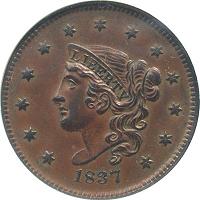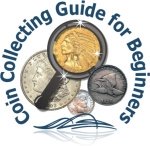 |
 |
|||||||||||||||||||||||||||||||||||||||||||||||||||||||||||||||||||||||||||||||||||||||||||||||||||||||||||||||||||||||||
|
| ||||||||||||||||||||||||||||||||||||||||||||||||||||||||||||||||||||||||||||||||||||||||||||||||||||||||||||||||||||||||||
United States Large Cents
Large cents have earned a spot in history as the first coins ever minted by the United States government on its own equipment and premises. They were minted from 1793 to 1857 at the mint in Philadelphia, the only U.S. Mint at the time. In 1815, however, a fire at the mint prevented the coin from being produced that year. People of that time period didn't like to carry the coins because they were so large and cumbersome. And they were also fairly heavy. The weight of a dollar's worth of these coins is about three pounds. These large coins have become an interesting part of history however, because they show us the value of money during this era. At the time they were in circulation, the coin was not called the "Large Cent". It was just the one cent coin of the day. Today it is called a large cent by coin collectors because compared to our modern day "penny", it is huge. This coin is larger that the modern quarter (about 27mm). All Large Cents were minted at the Philadelphia Mint and have no mint mark. These Large Coins, Made of Nearly Pure Copper,
|
||||||||||||||||||||||||||||||||||||||||||||||||||||||||||||||||||||||||||||||||||||||||||||||||||||||||||||||||||||||||||
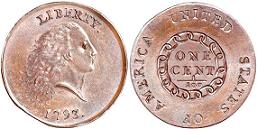
|
| Type | Flowing Hair - Chain Reverse |
| Designer | Henry Voigt |
| Years Minted | 1793 only |
| Weight | 13.48 grams |
| Composition | copper |
| Diameter | approx. 26-27 mm |
| Edge | bars and slender vine with leaves |
| Mintage | 36,103 |
Flowing Hair, Wreath Reverse 1793
Because of the strong reaction to the chain on the coin, it was removed later in 1793 and replaced with a wreath. The bust of Liberty was also redesigned with longer and wilder hair. There were about 63,000 coins made with the wreath on the reverse.
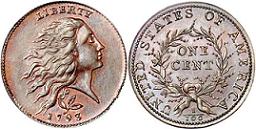
|
| Type | Flowing Hair - Wreath Reverse |
| Designer | Henry Voigt |
| Years Minted | 1793 only |
| Weight | 13.48 grams |
| Composition | copper |
| Diameter | approx. 26-28 mm |
| Edge | vine and bars or lettered ONE HUNDRED FOR A DOLLAR followed by either a single or double leaf |
| Mintage | 63,353 |
Liberty Cap 17931796
This design "tamed" the wild hair of Liberty and faced her to the right. A cap, an ancient symbol of freedom, was added and the wreath on the reverse was revised to a laurel wreath.
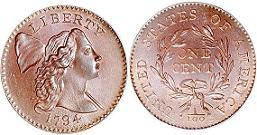
|
| Type | Liberty Cap |
| Designer |
1793-1795 - thick planchet - Joseph Wright 1795-1796 - thin planchet - John Smith Gardner |
| Years Minted | 1793-1796 |
| Weight |
1793-1795 13.48 grams 1795-1796 10.89 grams |
| Composition | copper |
| Diameter | approx. 29 mm |
| Edge |
1793-1795 ONE HUNDRED FOR A DOLLAR followed by a single leaf 1795-1796 plain |
| Mintage |
1793 - 11,056 1794 - 918,521 1795 - 37,000 lettered edge 1795 - 501,500 plain edge 1796 - 109,825 |
Draped Bust 17961807
On this design, Liberty is wearing flowing hair tied with a ribbon and has a drapery at the neckline. The reverse design features an olive wreath.
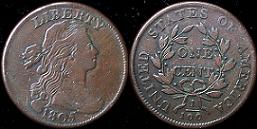
|
| Type | Draped Bust |
| Designer | Robert Scot |
| Years Minted | 1796-1807 |
| Weight | 10.89 grams |
| Composition | copper |
| Diameter | approx. 29 mm |
| Edge | plain |
| Mintage |
1796 - 363,375 1797 - 897,510 1798-99 - 1,841,745 1800 - 2,822,175 1801 - 1,362,837 1802 - 3,435,100 1803 - 3,131,691 1804 - 96,500 1805 - 941,116 1806 - 348,000 1807 - 829,221 |
Classic Head 18081814
This design of the coin gets its name from the fillet (narrow headband) Liberty is wearing. It seems odd that this particular headgear was chosen for Liberty as it is a type of headgear only worn by male athletes in ancient Greece, given to them as prizes for winning local sporting events.
The copper used in the Classic Head cents contained less metallic impurity than previous copper used and as a result the coins were softer. This allowed them wear and corrode more easily than other issues so it is really difficult to find these coins in good condition.
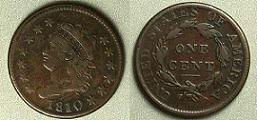
|
| Type | Classic Head |
| Designer | John Reich |
| Years Minted | 1808-1814 |
| Weight | 10.89 grams |
| Composition | copper |
| Diameter | approx. 29 mm |
| Edge | plain |
| Mintage |
1808 - 1,007,000 1809 - 222,867 1810 - 1,458,500 1811 - 218,025 1812 - 1,075,500 1813 - 418,000 1814 - 257,830 |
Liberty Head or Coronet cents 18161857
Matron Head (18161839)- Due to much criticism of the Classic Head from the public, the coin was redesigned in 1816. The portrait was enlarged and Liberty was given a much more mature look. This led to it being referred to as the Matron Head. Liberty was also surrounded with stars along the outer edge of the coin.
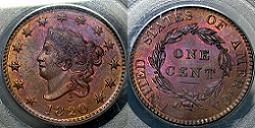
|
| Type | Liberty Head - Matron Head |
| Designer |
1816-1836 Robert Scot 1837-1839 Christian Gobrecht |
| Years Minted | 1816-1839 |
| Weight | 10.89 grams |
| Composition | copper |
| Diameter |
1816-1836 approx. 28-29 mm 1837-1839 approx. 27.5 mm |
| Edge | plain |
| Mintage |
1816 - 2,820,982 1817 - 3,948,400 1818 - 3,167,000 1819 - 2,671,000 1820 - 4,407,550 1821 - 389,000 1822 - 2,072,339 1823-24 - 1,262,000 1825 - 1,461,100 1826 - 1,517,425 1827 - 2,357,732 1828 - 2,260,624 1829 - 1,414,500 1830 - 1,711,500 1831 - 3,359,260 1832 - 2,362,000 1833 - 2,739,000 1834 - 1,855,100 1835 - 3,878,400 1836 - 2,111,000 1837 - 5,558,300 1838 - 6,370,200 1839 - 3,128,661 |
Braided Hair or Petite Head (18391857)- Once again, public critisism prompted one last major change to the coin. It was updated by giving Liberty a slimmer, more youthful appearance.
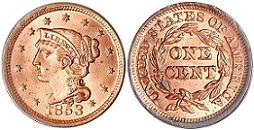
|
| Type | Liberty Head Large Cent - Braided Hair |
| Designer | Christain Gobrecht |
| Years Minted | 1839-1857 |
| Weight | 10.89 grams |
| Composition | copper |
| Diameter | approx. 27.5 mm |
| Edge | plain |
| Mintage |
1839 - included in mintage numbers above for 1839 1840 - 2,462,700 1841 - 1,5973670 1842 - 2,383,390 1843 - 2,425,342 1844 - 2,398,752 1845 - 3,894,804 1846 - 4,120,800 1847 - 6,183,669 1848 - 6,415,799 1849 - 4,178,500 1850 - 4,426,844 1851 - 9,889,707 1852 - 5,063,094 1853 - 6,641,131 1854 - 4,236,156 1855 - 1,574,829 1856 - 2,690,463 1857 - 333,546 |
A mint employee coined several large cents dated 1868 about 11 years after the large cent was discontinued. I am sure he knew they would be instant rarities to collectors. And I suppose he was right as less than a dozen of these unofficial issues are known to survive.
Price Guides
PCGS Price Guide.
Numismedia Fair Market Value Price guide.
Also see Coin Values Discovery for grading images and value charts for your large cent.
In 1857 the Large Cent was officially replaced by the modern-size one-cent coin we know today as the "penny". One reason, other than the bulk and heaviness of the coin, is that the copper content became more valuable than the coin's face value.
What Would You Like To Do Now?
Return From Large Cents to US Coins
See Where the Mint Mark is located on US CoinsIf You Can't Find What You Are Looking For....
Search This Site!


Eva Sue Duke - R-3147094
***coinmanad.shtml***
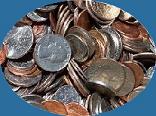
***ebay120x600.shtml***
|
Surf Tip
When you see a word underlined in brown, like thisThis is an example of what to expect when you hover over words underlined in brown throughout this site., hover over it with your cursor to see the definition of that word. |
Template Design
